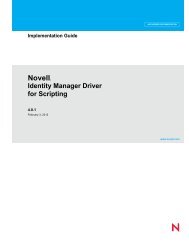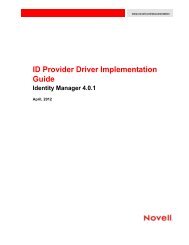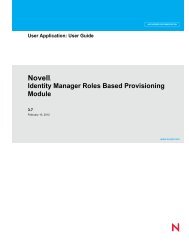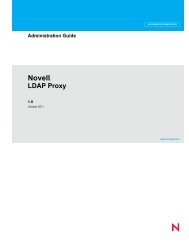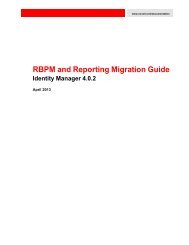Novell iManager 2.7.5 Administration Guide - NetIQ
Novell iManager 2.7.5 Administration Guide - NetIQ
Novell iManager 2.7.5 Administration Guide - NetIQ
You also want an ePaper? Increase the reach of your titles
YUMPU automatically turns print PDFs into web optimized ePapers that Google loves.
10.4.2 Linux<br />
To view or capture the debug output from an installer, open and copy the console output to a<br />
text file for later review.<br />
3a Immediately after launching the installer, hold down the Ctrl key until a console window<br />
appears.<br />
3b After the install has completed, click the icon in the upper left corner of the console window<br />
and select Properties > Layout.<br />
3c Change the buffer size to 3000, then click OK.<br />
3d In the Layout window, select Edit > Select All > Edit > Copy.<br />
3e Open a text editor and paste the output of the debug in it.<br />
4 Identify and correct any errors or stack traces, then rerun the install.<br />
1 Check the <strong>iManager</strong> install log file (/var/log/<strong>Novell</strong>/<br />
<strong>iManager</strong>_Install_2.7_InstallLog.log) for any errors.<br />
2 If the log file does not give sufficient information to identify the problem, rerun the install in<br />
debug mode.<br />
At the command line, type the following:<br />
export LAX_DEBUG=true<br />
3 Identify and correct any errors or stack traces, then rerun the install.<br />
10.5 High Availability: Running <strong>iManager</strong> in a Clustered<br />
Environment<br />
Although <strong>iManager</strong> is a session‐based tool that ships without any failover features, you can run it in<br />
a clustered environment. For more information about clustering, see the OES Clustering<br />
documentation (http://www.novell.com/documentation/oes/cluster‐services.html#cluster‐services).<br />
1 Install and configure <strong>iManager</strong> on the nodes in the cluster where the virtual IP is moved to (that<br />
is, an Active/Active cluster).<br />
If the node running <strong>iManager</strong> fails, <strong>Novell</strong> Cluster Services detects the node failure and moves<br />
(reloads) the virtual IP address on another node in the cluster.<br />
2 Using the Generic_IP_Service template that ships with <strong>Novell</strong> Cluster Services, create a new<br />
cluster resource called <strong>iManager</strong>.<br />
This cluster resource uses a virtual IP address that moves between nodes in the cluster. When<br />
creating a new cluster resource, the wizard steps you through the creation of a load script and an<br />
unload script.<br />
3 Verify the load and unload scripts.<br />
The load script should contain only the following lines (any other lines should be commented<br />
out):<br />
. /opt/novell/ncs/lib/ncsfuncs<br />
exit_on_error add_secondary_ipaddress xxx.xxx.xxx.xxx<br />
exit 0<br />
Best Practices and Common Questions 107




